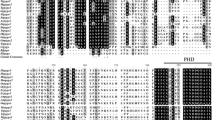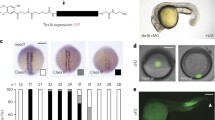Abstract
We have previously isolated a cDNA clone coding for Xenopus AP-2rep (activator protein-2 repressor), a member of the Krüppel-like factor family, and reported its expression pattern in developing Xenopus embryos. In the present study, the physiological function of AP-2rep in the morphogenetic movements of the dorsal mesoderm and ectoderm was investigated. Embryos injected with either AP-2rep or VP16repC (a dominant-negative mutant) into the dorsal marginal zone at the 4-cell stage exhibited abnormal morphology in dorsal structures. Both AP-2rep and VP16repC also inhibited the elongation of animal cap explants treated with activin without affecting the expression of differentiation markers. Whole-mount in situ hybridization analysis revealed that expression of brachyury and Wnt11 was greatly suppressed by injection of VP16repC or AP-2rep morpholino, but expression was restored by the simultaneous injection of wild-type AP-2rep RNA. Furthermore, the morphogenetic abnormality induced by injection of VP16repC or AP-2rep morpholino was restored by simultaneous injection of brachyury or Wnt11 mRNA. These results show that AP-2rep is involved in the morphogenesis of the mesoderm at the gastrula stage, via the brachyury and/or Wnt pathways.







Similar content being viewed by others
References
Borchers A, Fonar Y, Frank D, Baker JC (2006) XNF-ATc3 affects neural convergent extension. Development 133:1745–1755
Carron C, Bourdelas A, Li HY, Boucaut JC, Shi DL (2005) Antagonistic interaction between IGF and Wnt/JNK signaling in convergent extension in Xenopus embryo. Mech Dev 122:1234–1247
Chung HA, Hyodo-Miura J, Nagamune T, Ueno N (2005) FGF signal regulates gastrulation cell movements and morphology through its target NRH. Dev Biol 282:95–110
Clements D, Friday RV, Woodland HR (1999) Mode of action of VegT in mesoderm and endoderm formation. Development 126:4903–4911
Conlon FL, Smith JC (1999) Interference with brachyury function inhibits convergent extension, causes apoptosis, and reveals separate requirements in the FGF and activin signalling pathways. Dev Biol 213:85–100
Conlon FL, Sedgwick SG, Weston KM, Smith JC (1996) Inhibition of Xbra transcription activation causes defects in mesodermal patterning and reveals autoregulation of Xbra in dorsal mesoderm. Development 122:2427–2435
Darken RS, Scola AM, Rakeman AS, Das G, Mlodzik M, Wilson PA (2002) The planar polarity gene strabismus regulates convergent extension movements in Xenopus. EMBO J 21:976–985
Davidson LA, Keller RE (1999) Neural tube closure in Xenopus laevis involves medial migration, directed protrusive activity, cell intercalation and convergent extension. Development 126:4547–4556
Elul T, Keller R (2000) Monopolar protrusive activity: a new morphogenic cell behavior in the neural plate dependent on vertical interactions with the mesoderm in Xenopus. Dev Biol 224:3–19
Goto T, Hasegawa K, Kinoshita T, Kubota HY (2001) A novel POZ/zinc finger protein, champignon, interferes with gastrulation movements in Xenopus. Dev Dyn 221:14–25
Gotoh M, Izutsu Y, Maéno M (2003) Complementary expression of AP-2 and AP-2rep in ectodermal derivatives of Xenopus embryos. Dev Genes Evol 213:363–367
Hardin J, Keller R (1988) The behaviour and function of bottle cells during gastrulation of Xenopus laevis. Development 103:211–230
Homma M, Inui M, Fukui A, Michiue T, Okabayashi K, Asashima M (2007) A novel gene, BENI is required for the convergent extension during Xenopus laevis gastrulation. Dev Biol 303:270–280
Imhof A, Schuierer M, Werner O, Moser M, Roth C, Bauer R, Buettner R (1999) Transcriptional regulation of the AP-2α promoter by BTEB-1 and AP-2rep, a novel wt-1/erg-related zinc finger repressor. Mol Cell Biol 19:194–204
Isaacs HV, Pownall ME, Slack JM (1994) eFGF regulates Xbra expression during Xenopus gastrulation. EMBO J 13:4469–4481
Keller RE (1980) The cellular basis of epiboly: an SEM study of deep-cell rearrangement during gastrulation in Xenopus laevis. J Embryol Exp Morphol 60:201–234
Keller R, Shih J, Sater A (1992) The cellular basis of the convergence and extension of the Xenopus neural plate. Dev Dyn 193:199–217
Keller R, Davidson L, Edlund A, Elul T, Ezin M, Shook D, Skoglund P (2000) Mechanisms of convergence and extension by cell intercalation. Philos Trans R Soc Lond Biol 355:897–922
Kim GH, Han JK (2005) JNK and ROKα function in the noncanonical Wnt/RhoA signaling pathway to regulate Xenopus convergent extension movements. Dev Dyn 232:958–968
Kinoshita N, Iioka H, Miyakoshi A, Ueno N (2003) PKCδ is essential for Dishevelled function in a noncanonical Wnt pathway that regulates Xenopus convergent extension movements. Genes Dev 17:1663–1676
Klymkowsky MW, Hanken J (1991) Whole-mount staining of Xenopus and other vertebrates. Methods Cell Biol 36:419–441
Kofron M, Demel T, Xanthos J, Lohr J, Sun B, Sive H, Osada S, Wright C, Wylie C, Heasman J (1999) Mesoderm induction in Xenopus is a zygotic event regulated by maternal VegT via TGFβ growth factors. Development 126:5759–5770
Kühl M (2002) Non-canonical Wnt signaling in Xenopus: regulation of axis formation and gastrulation. Semin Cell Dev Biol 13:243–249
Kwan KM, Kirschner MW (2003) Xbra functions as a switch between cell migration and convergent extension in the Xenopus gastrula. Development 130:1961–1972
Luo T, Matsuo-Takasaki M, Thomas ML, Weeks DL, Sargent TD (2002) Transcription factor AP-2 is an essential and direct regulator of epidermal development in Xenopus. Dev Biol 245:136–144
Luo T, Leedagger YH, Saint-Jeannet JP, Sargent TD (2003) Induction of neural crest in Xenopus by transcription factor AP2α. Proc Natl Acad Sci USA 100:532–537
Luo T, Zhang Y, Khadka D, Rangarajan J, Cho KW, Sargent TD (2005) Regulatory targets for transcription factor AP2 in Xenopus embryos. Dev Growth Differ 47:403–413
Mlodzik M (1999) Planar polarity in the Drosophila eye: a multi-faceted view of signaling specificity and cross-talk. EMBO J 18:6873–6879
Nieuwkoop PD, Faber J (1994) Normal table of Xenopus laevis (Daudin). Garland, New York
Nottoli T, Hagopian-Donaldson S, Zhang J, Perkins A, Williams T (1998) AP-2-null cells disrupt morphogenesis of the eye, face, and limbs in chimeric mice. Proc Natl Acad Sci USA 95:13714–13719
Ohkawara B, Yamamoto TS, Tada M, Ueno N (2003) Role of glypican 4 in the regulation of convergent extension movements during gastrulation in Xenopus laevis. Development 130:2129–2138
Oates AC, Pratt SJ, Vail B, Yan YL, Ho RK, Johnson SL, Postlethwait JH, Zon LI (2001) The zebrafish klf gene family. Blood 15:1792–1801
Roth C, Schuiere M, Günther K, Buettner R (2000) Genomic structure and DNA binding properties of the human zinc finger transcriptional repressor AP-2rep (KLF12). Genomics 63:384–390
Saka Y, Tada M, Smith JC (2000) A screen for targets of the Xenopus T-box gene Xbra. Mech Dev 93:27–39
Schorle H, Meier P, Buchrt M, Jaenisch R, Mitchell PJ (1996) Transcription factor AP-2 essential for cranial closure and craniofacial development. Nature 381:235–238
Shain DH, Züber MX (1996) Sodium dodecyl sulfate (SDS)-based whole-mount in situ hybridization of Xenopus embryo. J Biochem Biophys Meth 31:185–188
Shibata M, Itoh M, Hikasa H, Taira S, Taira M (2005) Role of crescent in convergent extension movements by modulating Wnt signaling in early Xenopus embryogenesis. Mech Dev 122:1322–1339
Tada M, Smith JC (2000) Xwnt11 is a target of Xenopus brachyury: regulation of gastrulation movements via dishevelled, but not through the canonical Wnt pathway. Development 127:2227–2238
Tada M, Concha ML, Heisenberg CP (2002) Non-canonical Wnt signalling and regulation of gastrulation movements. Semin Cell Dev Biol 13:251–260
Tahinci E, Thorne CA, Franklin JL, Salic A, Christian KM, Lee LA, Coffey RJ, Lee E (2007) Lrp6 is required for convergent extension during Xenopus gastrulation. Development 134:4095–4106
Takeuchi M, Nakabayashi J, Sakaguchi T, Yamamoto TS, Takahashi H, Takeda H, Ueno N (2003) The prickle-related gene in vertebrates is essential for gastrulation cell movements. Curr Biol 13:674–679
Turner J, Crossley M (1999) Mammalian Krüppel-like transcription factors: more than just a pretty finger. Trends Biochem Sci 24:236–240
Wallingford JB, Harland RM (2001) Xenopus Dishevelled signaling regulates both neural and mesodermal convergent extension: parallel forces elongating the body axis. Development 128:2581–2592
Wallingford JB, Harland RM (2002) Neural tube closure requires Dishevelled-dependent convergent extension of the midline. Development 129:5815–5825
Wallingford JB, Rowning BA, Vogeli KM, Rothbacher U, Fraser SE, Harland RM (2000) Dishevelled controls cell polarity during Xenopus gatrulation. Nature 405:81–85
West-Mays JA, Zhang J, Nottoli T, Hagopian-Donaldson S, Libby D, Strissel KJ, Williams T (1999) AP-2α transcription factor is required for early morphogenesis of the lens vesicle. Dev Biol 206:46–62
West-Mays JA, Clyle BM, Piatigorsky J, Papagiotas S, Libby D (2002) Ectopic expression of AP-2α transcription factor in the lens disrupts fiber cell differentiation. Dev Biol 245:13–27
West-Mays JA, Sivak JM, Papagiotas SS, Kim J, Nottoli T, Williams T, Fini ME (2003) Positive influence of AP-2α transcription factor on cadherin gene expression and differentiation of the ocular surface. Differentiation 71:206–216
Wilson V, Manson L, Skarnes WC, Beddington RS (1995) The T gene is necessary for normal mesodermal morphogenetic cell movements during gastrulation. Development 121:877–886
Winklbauer R, Schürfeld M (1999) Vegetal rotation, a new gastrulation movement involved in the internalization of the mesoderm and endoderm in Xenopus. Development 126:3703–3713
Zhang J, Hagopian-Donaldson S, Serbedzija G, Elsemore J, Plehn-Dujowich D, McMahon AP, Flavell RA, Williams T (1996) Neural tube, skeletal and body wall defects in mice lacking transcription factor AP-2. Nature 381:238–241
Acknowledgements
We thank Drs. R. Buettner and M. Asashima for supplying plasmids.
Author information
Authors and Affiliations
Corresponding author
Additional information
This work was partly supported by a grant-in-aid from The Ministry of Education, Science, and Culture of Japan.
Electronic supplementary material
Below is the link to the electronic supplementary material.
Supplement Fig. 1.
Differentiation of neural, muscle, and notochord tissues occurred in AP-2rep- or VP16repC-injected embryos. Embryos were injected with AP-2rep (1000 pg) or VP16repC (100 pg) into the dorsal and ventral marginal zone regions (all the blastomeres) at the 4-cell stage and cultured until stage 39. Expression of N-CAM (a-c), muscle actin (d-f), and keratan sulfate (g-i) was analyzed by whole-mount antibody staining (arrows positive signals stained by each antibody). All the embryos injected with either AP-2rep or VP16repC show positive staining with these markers (a, n=2; b, n=5; c, n=5; d, n=2; e, n=5; f, n=5; g, n=4; h, n=5; i, n=5) (PDF 70.32 KB)
Rights and permissions
About this article
Cite this article
Saito, Y., Gotoh, M., Ujiie, Y. et al. Involvement of AP-2rep in morphogenesis of the axial mesoderm in Xenopus embryo. Cell Tissue Res 335, 357–369 (2009). https://doi.org/10.1007/s00441-008-0712-7
Received:
Accepted:
Published:
Issue Date:
DOI: https://doi.org/10.1007/s00441-008-0712-7




